
We embark on a new week and a fresh focus on another up and coming EV company, Arrival. The UK-based automaker offers a unique and efficient approach to electric vehicles from production through delivery. Its pipeline for manufacturing, assembly, and software keeps footprints concise and minimalistic while others are going bigger and bigger. These are some of the many reasons Arrival is an EV company to watch.
Arrival is an EV company built around upon three major focuses: sustainability, scalability, and cost-effectiveness. Its strategy in challenging legacy production processes and maintenance is what has led Arrival to where it sits today. An exciting EV manufacturer designing and implementing its own components, software, and assembly processes in unique ways to maximize all aspects from production. From supply chains to fleet repairs, Arrival has planned for it and strategized.
Arrival’s journey in EV manufacturing
Since its founding in 2015, Arrival has chosen to face some of the biggest challenges in transportation and mobility head on. It currently employs over 1,300 individuals across eight different countries, including its two headquarters in London, UK and Charlotte, North Carolina in the US.
So far, the automaker has unveiled two EVs in its production pipeline, the Arrival Van and the Arrival Bus. The Van first caught Electrek’s eye back in 2017, when Arrival began a trial with the UK’s royal mail. Since then, Arrival like many EV startups, has had to pivot and reconfigure its strategy in reaching scalability. In an interview with Electrek, Arrival’s Chief of Product, Patrick Bion explained the automaker’s journey toward scalability:
Just having that vision of how we’re going to take everything we do, and lead it to have as big an impact as possible, as quickly as possible is really important. That’s why we’ve had to rethink the manufacturing process, that’s why we’ve taken the time to design the vehicles in a way that means we’re gonna bring a ton of new variants and configurations to market very quickly. Not just that, but around the world. Solving the problem of getting people these vehicles quicker in a cost effective way is something we think we can do.
The design process
This revelation at Arrival has not come without its fair share of R&D either. While the company is finally at a point where it can truly begin to ramp of production of its first EVs, its approach to design wasn’t always so granular. Bion elaborates:
The vehicles are designed from the ground up. Originally, we didn’t set out to design new materials and new components, and everything we have. We found that we’ve had to in order to ‘A’ meet the price, and ‘B’ reach scalability. We design whatever we need to to make sure we can get the price right and the performance right. So that’s led to materials, components, software, and the assembly process.
Arrival seems to have come out the other end of this design pivot better off, too. Its minimalistic approach to design and assembly is complimented by its in-house production of proprietary components and software. Furthermore, it limits supply chain dependency and helps keep costs under Arrival’s control more. A pivotal element in this process is Arrival’s unique approach to assembly by using “microfactories.”
Arrival’s EV microfactory approach
While automakers like Tesla and Lucid Motors are pouring hundreds of millions of dollars into breaking ground on mega production facilities, Arrival has taken the opposite approach. In what the EV manufacturer calls its “microfactory,” Arrival takes existing industrial facilities and installs its own assembly cells that are quickly and efficiently implemented.
This strategy removes the need for any special foundations, pits for painting, or other assembly processes. Individual assembly cells are instead, bolted directly into the concrete floor. Each cell includes 3-4 off the shelf robots, plus all necessary equipment to guide parts around the facility.
In addition to the cells themselves, Arrival utilizes non-specific production processes. Meaning it has consciously designed all its vehicles to use widely universal means of assembly. All the EVs, for example, are built around pre-anodized aluminum and are assembled together using structural adhesive and fasteners. These materials are used across all of Arrival’s products, from vans to buses, and future EVs.
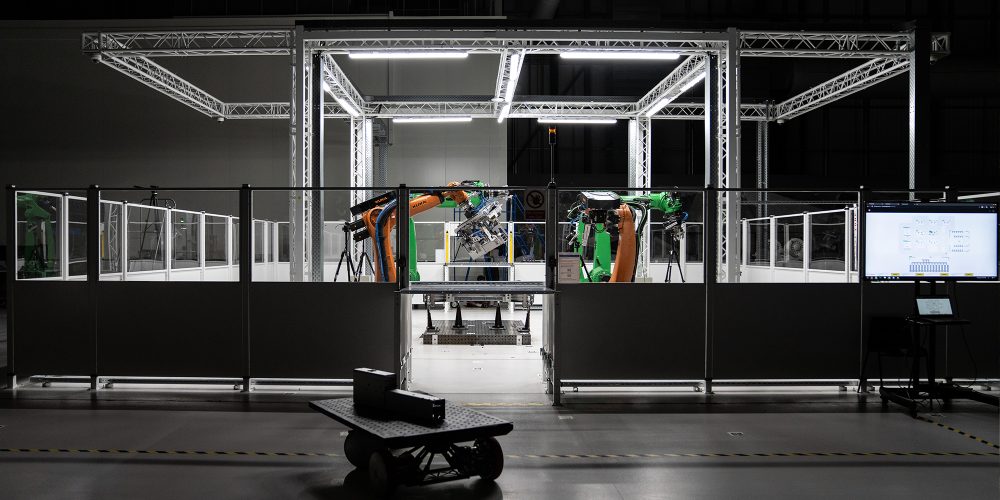
Shortening the supply chain
Facilities are one hurdle, but supply chain is a whole other monster, as we’ve seen other EV manufacturers struggle, especially due to delays and shortages during a pandemic. To counter this, Arrival plans to use microfactories to source as many supplies locally, to reduce costs and quicken turnaround. Arrival’s Patrick Bion explained it to Electrek:
Our supply chain is coming along, but we’ve had to work very hard on to align it with the microfactory model. Rather than giving each supplier a vision of them sending all their parts to one facility, we have to be a bit more intelligent and coordinate different supplies for different regions. Raw materials can be sourced locally, to produce the most sustainable, and cost-effective product possible.
Arrival’s current focus is to develop the efficiency of the microfactory model where it needs to be, then copy and paste it around the globe from there. Currently, Arrival has a microfactory in the setup and testing process an hour north of London, in Bicester. That is where it will manufacture its first Arrival Vans for the UK.
Additionally, there is a microfactory in South Carolina focused on manufacturing the Arrival Bus. The Arrival team told Electrek that a microfactory for Vans for the US is in the works. The company is also planning a fourth facility in mainland Europe. Each Arrival Van microfactory can house 20-30 assembly cells and will produce 10,000 Vans a year. More on the vans soon, but first, let’s start with the bus.
The Arrival Bus
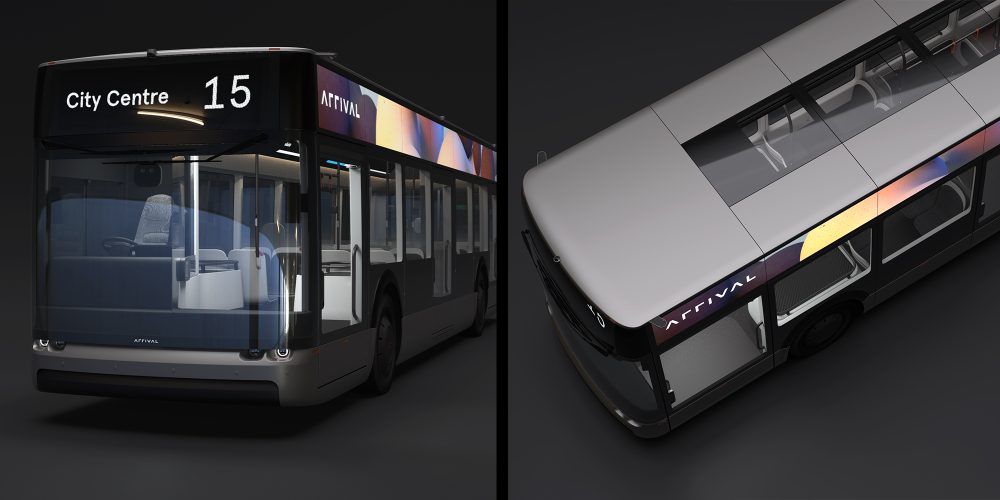
Arrival’s EV Bus offers a great example of the modular platform capabilities and efficient design. According to its website, the Arrival Bus features a single front door with a passenger seating capacity of 36 across an entirely flat floor, allowing greater accessibility, as well as more usable standing space for passengers. Overall, the Arrival Bus can carry 80-125 passengers.
Stepping aboard, cantilever “floating” seats and seamless surfaces aid in quick and easy cleaning. Up above, wrap-around LED screens display the given route below a panoramic glass roof.

In terms of specs, the bus will have a max battery capacity of 310.8 kWh, garnering between 200-408 km (~124-254 mi) range depending on the payload (up to 8,000 kg or 17,637 lbs).
Last month, Arrival announced a trial with First Bus, one of the UKs largest transport operators. With plans to operate at zero-emissions by 2035, First Bus will be testing Arrival’s EV version on UK routes this fall. The Arrival Bus is the first scheduled EV to hit to market. Production is currently slated to begin in Q4 2021.
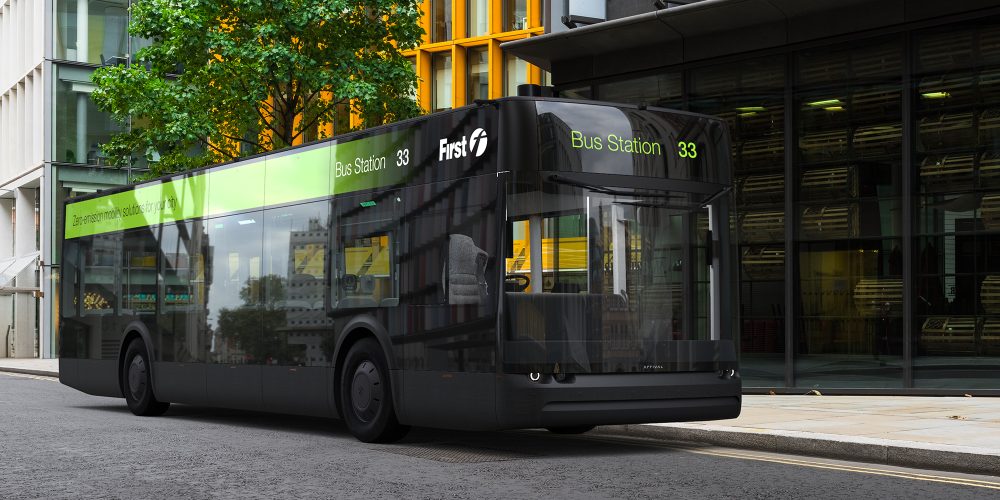
The Arrival Van
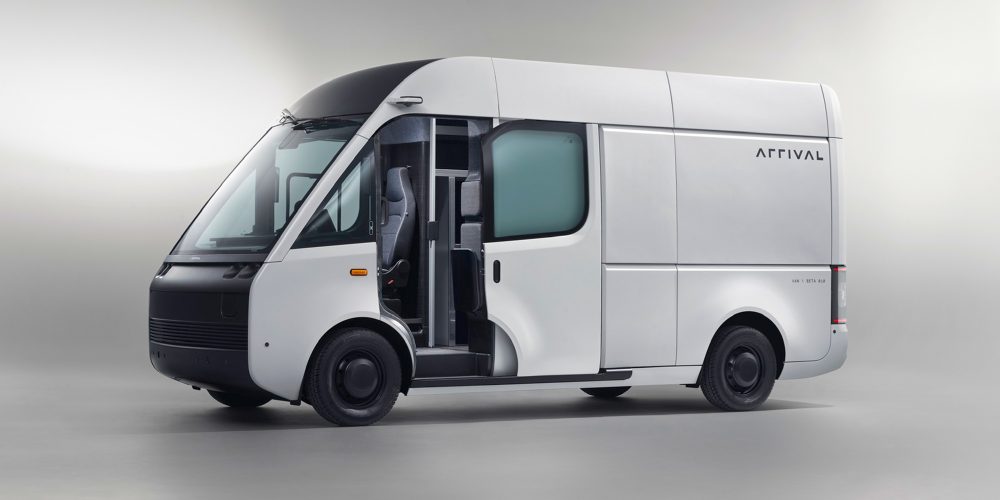
An electric van is the newest vehicle to enter Arrival’s production pipeline. With a focus on connected and sustainable fleets in mind, the Arrival Van has much to offer in terms of price and maintenance. Plus it has the automaker’s DNA all over it. Arrival calls these, “plug and play components.”
When we asked Arrival about these plug and play capabilities, we thought perhaps it meant brakes and steering by wire, but that is not the case. Arrival’s EVs, Van included, operate electrical assist steering and braking. Arrival’s Chief of Product elaborated further:
The ‘plug and play’ refers to the fact that the components are self-aware. When we put one in a vehicle, it knows what other components are in that vehicle, and it knows the health state of everything else in the vehicle. If you were to take one of our modules out and put it in another vehicle, it won’t work. It’s designed to work only when it’s in a particular vehicle.
As mentioned, Arrival designs its components itself. This includes computing platforms, battery modules, drive trains, electronics, and DC-DC converters. All are self-aware and function within a vehicle architecture that knows what it’s receiving. This awareness contributes to what Arrival calls its “eco-system.”
For the Arrival Van especially, the eco-system extends to fleet connectivity, knowing what each vehicle is doing and for how long. This can help with predictive maintenance amongst a number of other benefits for large fleets. Using this data on a more granular level will help fleet customers draw maximum efficiency from each of its Arrival vehicles. Arrival sees this as a massive opportunity to improve fleet efficiency and sustainability, all with zero-emissions.
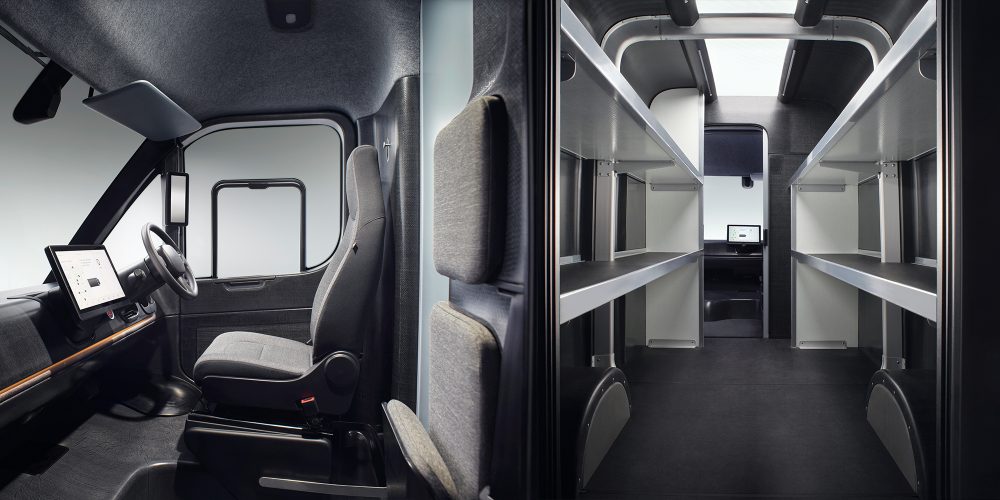
Van modularity and simplified maintenance
Consider this as prime example of Arrival’s quest to improve fleets. The company announced an order from UPS for 10,000 electric vans earlier this year. To maximize the efficiency of the eco-system, Arrival automated the doors on the custom UPS tailored vans. Specific van doors can open and close when a delivery driver is near. This saves mere seconds on each stop, but adds up over the course of a day, a week, and month across thousands of drivers.
Also consider Arrival’s unique approach to modular design, foregoing paint and complicated body work. Maintaining a fleet cosmetically should also prove easier, quicker, and most importantly cost less. When a delivery van needs a repair, it currently involves a custom body shop cutting metal, replacing, welding, and painting. That could take weeks and requires a library of parts in stock. Arrival’s panels, however, can easily be removed and replaced without painting. Since the company manufacturers these parts, they can produce them locally rather quickly, and get the EV back on the road instead of being out a week or two.
Another huge benefit Arrival has had the foresight to utilize is modular capabilities in size without sacrificing any changes to assembly, scalability, or maintenance.
Arrival Van specs
According to Arrival, its van will eventually be available in three different sizes. The first to arrive at market with be the 3.5-4 ton version.
Next will come a slightly lighter version of the Arrival Van, with a smaller width and length. Finally, a larger van will sit on an extended version of the original platform, at around 7.5 tons. This larger van will be geared toward the US market. That’s because as you may know, we like everything bigger over here.
What is most intriguing about this three van lineup is its similitude and interchangeability. The same assembly process is already in place, it can simply be scaled up or down. Furthermore, each and every van is comprised of the same core components. Realistically, fleets working with Arrival will be in a position where they will have the same interaction, service routines, digital connection, and data across a whole range of different sized products.
According to the specs of Arrival’s Van coming to the North American market, it will offer nearly 500 cubic feet of cargo room and both AC and DC charging. The battery capacities range in four variations starting at 67 kWh up to 133 kWh. That’s a peak charging capacity of 120 kW on DC and 11 kW AC. It will be able to travel an estimated range of 112 miles minimum on 67 kWh, and up to 211 miles on 133 kWh. Payloads range from 4,354 lbs down to 3,560 lbs, and the max speed is 75 mph.
The Arrival Van will begin testing in the UK and US this summer and is scheduled to begin production in Q3 of 2022. The automaker told Electrek that pricing on the Van and further details will be revealed later this year.
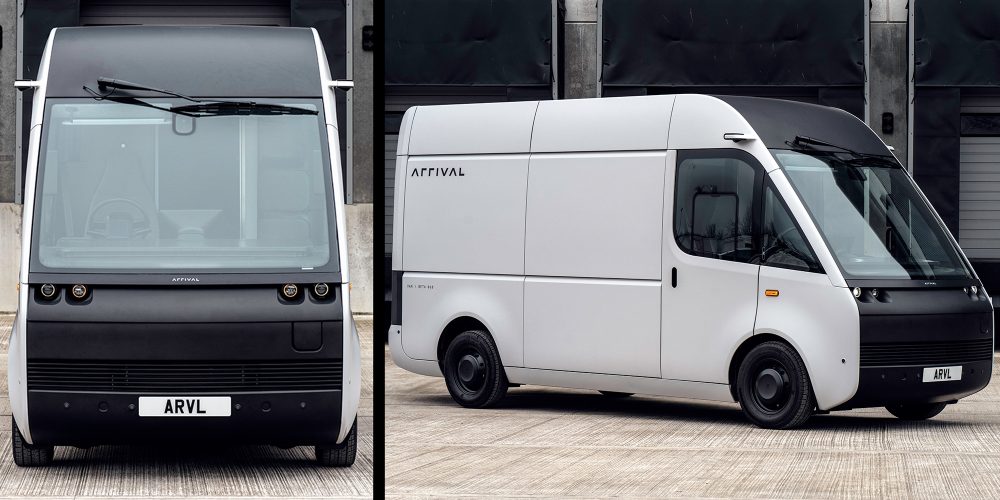
The future of Arrival
After researching Arrival throughly, it’s easy to get excited about what the automaker is working on. Funding shouldn’t be an issue either. In addition to the order from UPS, Arrival has also seen an investment of $111 million from Hyundai and Kia. Hyundai has previously mentioned plans to use Arrival’s platform and software technologies. Arrival said it hopes to make exciting new announcements about that collaboration at a later date.
Furthermore, Arrival recently announced a merger with CIIG Merger Group to enter the Nasdaq under the ticker $ARVL. The merger has already been approved by the SEC, and if everything goes to plan, the stock market should see Arrival on the ticker before the end of the month.
In addition to the Bus and Vans, Arrival has slyly listed a fourth EV on its website scheduled for 2023. It appears to be a rideshare or taxi vehicle, although Arrival would not comment on it just yet. In speaking with the automaker, however, the topic of ridesharing did come up. Arrival does see ridesharing as an interesting opportunity.
Overall, this is an Arrival six years in the making, on the cusp of full-fledged scalable production. In providing commercial vehicles with the technology of electric with the pricing of diesel, businesses should no longer have to pay a premium to be carbon conscious. Furthermore, Arrival’s microfactory model and local sourcing not only shortens supply chains, but quickens production.
For fleets, Arrival’s modular designs make them quicker and more cost effective to repair. Its proprietary software can contribute to its eco-system. EVs communicating internally and with one another, providing data for predictive maintenance before there is ever an issue.
Check back with Electrek for all updates and news surrounding Arrival and its EVs moving forward.
Subscribe to Electrek on YouTube for exclusive videos and subscribe to the podcast.
Author: Scooter Doll
Source: Electrek



